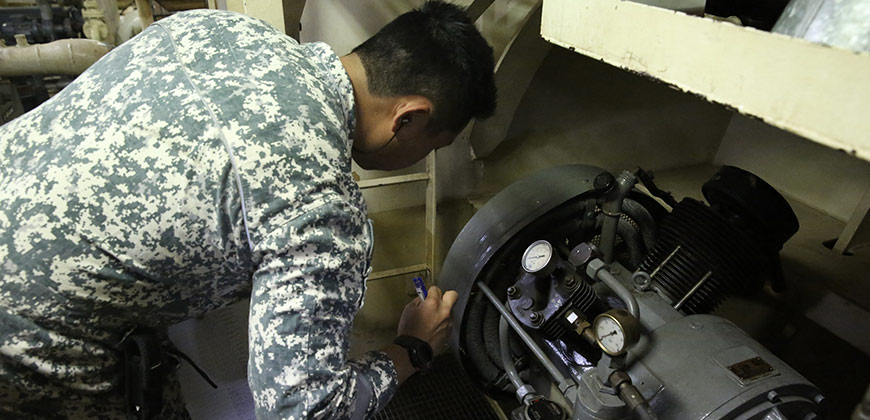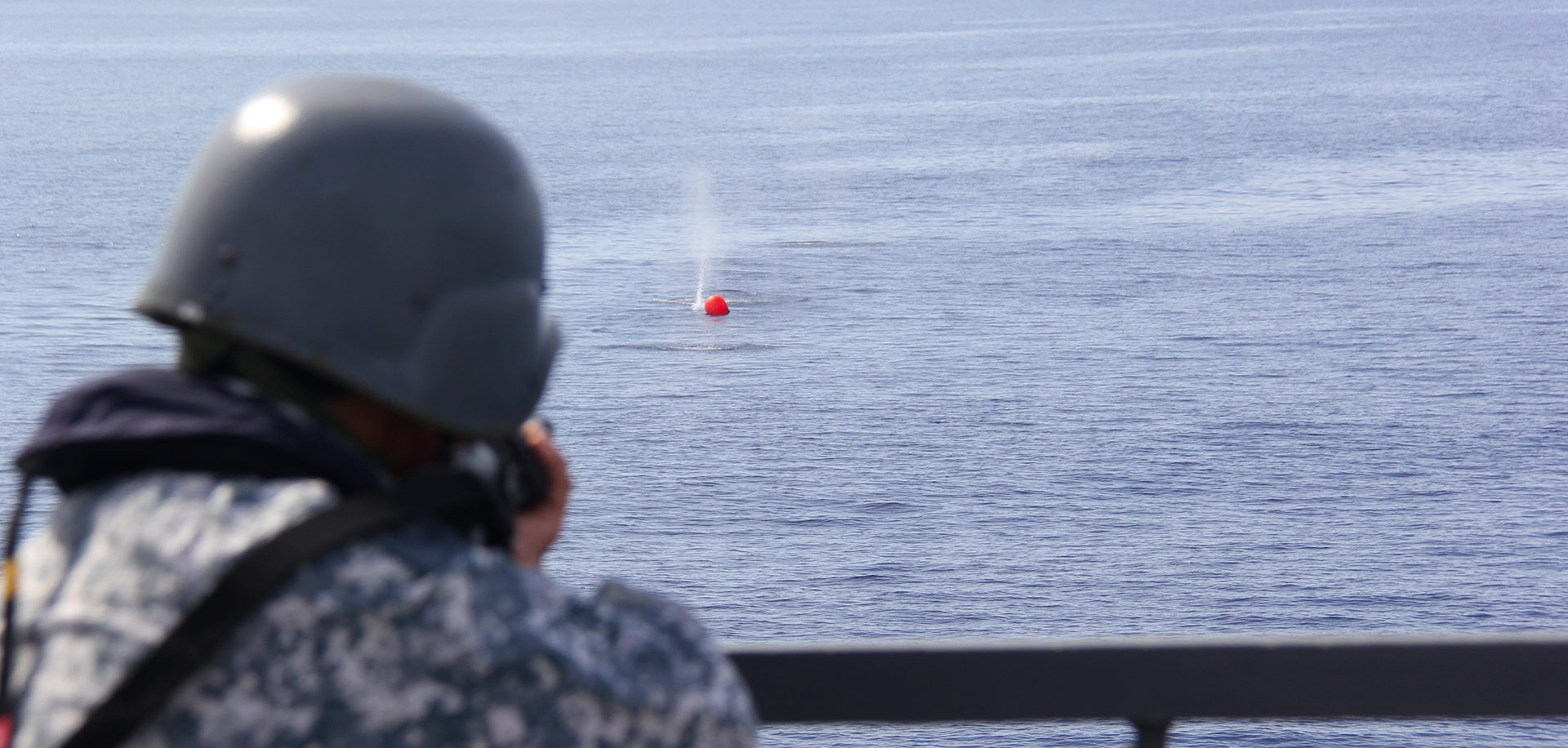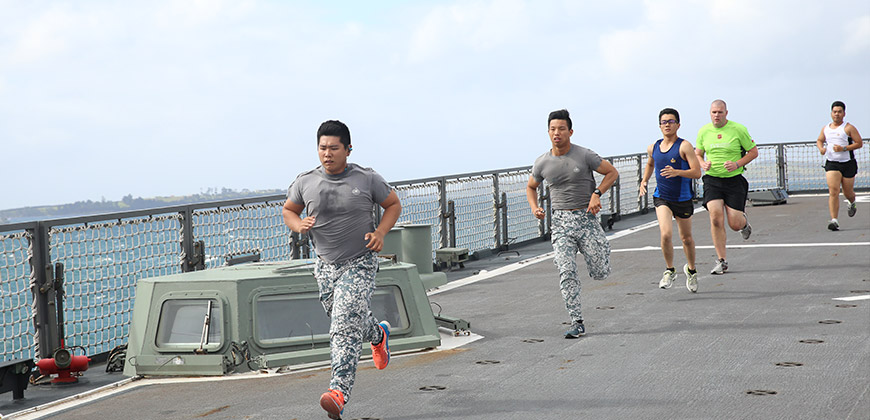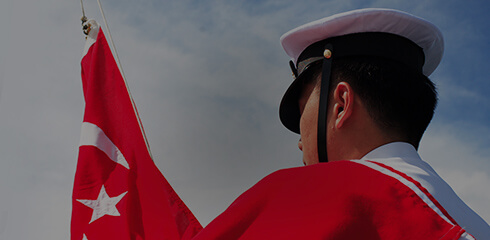From the Gulf of Aden to the South China Sea, the Republic of Singapore Navy (RSN) has been deployed to ports all over the world. Whether it is battling seasickness or bracing for rough seas, life out on the open sea is nothing like life on land.
In October 2016, the landing ship tank RSS Resolution took a six-day journey from Brisbane, Australia to Auckland, New Zealand to take part in the Royal New Zealand Navy’s 75th anniversary celebrations. For an exclusive peek into what life is like on a landing ship tank (LST), welcome on board RSS Resolution.
Morning Watch: 0400hrs–0800hrs
We are into the wee hours of the morning, but for 10 crew members, their duty watch has only just begun. Like all RSN warships, RSS Resolution follows the naval watch system, which allows a ship’s crew to operate and keep watch around the clock during voyages or operations.
Five crew members are in the Machinery Control Room (MCR), monitoring the status of the ship’s systems and engines. They watch screens keenly, keeping an eye on the blinking lights.
Up on the pitch-dark bridge, the other five watchkeepers are surrounded by glowing red and green buttons, their faces softly lit by dim radar screens. Two lookouts — armed with binoculars – scan the horizon, watching out for other seafarers. Out in the vast Tasman Sea, at night when the sky melds into the ink-dark sea, the waters are deceptively empty. But in the open sea, this is a dangerous assumption to make.
Unlike on land, there are no clearly defined lanes out at sea and collisions can occur all too easily. So the watchkeepers must be vigilant in watching both the radar screens and the horizon for nearby vessels.
Below decks, the kitchen is already bubbling with activity. Two naval chefs are tackling the task of putting together a hot, hearty meal for the whole warship. Menu items are discussed beforehand, and breakfast may contain anything from fried bee hoon, porridge to simple sandwiches — the crew members’ favourites back home. And yes, unlike other services of the Singapore Armed Forces, which have switched to commercial chefs, a naval chef remains a vocation in the Navy.
The sun is now edging over the horizon — the Morning Watch draws to a close. Watching the sun offers the watchkeepers more than just a beautiful start to the day – they use the sun’s position to check the accuracy of their navigational equipment, an age-old measure that remains in use on board our ships today.
At precisely 0730hrs, the Wakey Wakey Pipe pierces through the silence of the warship.
Forenoon Watch: 0800hrs–1200hrs
The day kicks off with the morning brief conducted by the executive officer (XO) or coxswain. Done in the briefing room, the crew will be given an update on the day’s activities, safety matters and any other instructions.
This is also when the sailors report any health issues to the medical officer. In the confined space of a ship, contagious disease could spread rapidly, so illnesses must be detected as early as possible.
If all is well, the afternoon watchmen will close up on the bridge — that is, report to take over the previous watch — while the rest of the crew carry on with the constant work required to keep a warship running: scheduled equipment maintenance, seamanship work, deck maintenance and daily combat system checks. In the meantime, our naval chefs will be preparing for lunch. The task of feeding 90 shipmates — including themselves — never stops.
Afternoon Watch: 1200hrs–1600hrs
At high noon, or 1200hrs, a crew member will make a noonday report through the public address (PA) system to the entire ship. The report consists of the current position of the ship (in latitudes and longitudes), estimated time of arrival, the distance to the next port of call (in this case, Auckland, New Zealand), upcoming lunch and dinner menus and, interestingly, the Joke of the Day.
Here’s an example: what is red and smells like blue paint? “Red paint” is the dour reply. “Ha-ha-ha.” All over the ship, the crew cringes in response, playfully jibing the joke-teller for the awful joke.
After lunch, it’s back to business: there is no such thing as a post-lunch lull for the crew of a RSN warship.
It is time for an Anti-Surface Warfare Drill — the crew gears up for action. The scenario: small boats are zipping across the waves towards the LST, and they are not friendly. The men on board are armed and they are primed for hostile action.
Nearly every member of RSS Resolution’s crew closes up at their action stations — from those in the Combat Information Centre (CIC) to the fire-fighting party in the MCR, which will be on standby to put out fires.
The “attack” escalates; the small boats have crossed the last warning line, and the LST must take action. The weapons specialists are ready. Today, they are training in both small arms and the A-gun, the Oto Melara 76mm. Before the terrorists can launch an explosive, the warship fires her weapons, neutralising the threat effectively.
But the crew cannot relax — the exercise controller decides to ratchet up the action. The PA system blares: “For exercise, for exercise, for exercise. Hands to action station, hands to action station. Assume damage control state 1 condition zulu.”
Now, the fire-fighting and damage control drills start. The fire-fighting party dons their fireproof suits in under three minutes flat, and troops off to battle the flames. Where the ship has sustained damage, the crew hurries to stop up the hole – the torrents of water gushing in could sink the ship.
Their extensive training has clearly paid off as the crew executes the drills to the satisfaction of their commanding officer and supervisors. It has been a productive afternoon for the crew.
First Dog Watch: 1600hrs–1800hrs
The next two watches are split into two-hour stretches — and there are good reasons for that. Splitting the watch creates an odd number of watches on board the ship. This allows crew members to stand watch at different times every day. Besides, this allows those in the First and Last Dog Watches to have their dinners.
Meanwhile, the First Dog Watch, from 1600hrs to 1800hrs, is when the rest of the crew engages in physical training, from visiting the well-equipped gym to hitting the flight deck for a spot of running.
Last Dog Watch: 1800hrs–2000hrs
The Last Dog Watch is when dinner is served — although that is not the last meal. After dinner, the naval chefs will prepare night snacks for the crew, which may include everything from brownies and cheesecakes to mee sua. To prepare for the nightly inspection conducted by the XO and coxswain during the First Watch, the crew will be busy getting everything ship shape.
Up on the bridge, the watchkeepers turn off the lights and dim the brightness of the screens as much as possible. This is to prevent the watchkeepers from getting night blindness, so that they can better see the waters outside. Throughout the ship, lights are also dimmed or switched to red light, which is called light discipline, observed on a nightly basis for tactical purposes.
First Watch: 2000hrs–2359hrs
It is 2000hrs — the First Watch.
Crewmembers will take this time to perform ‘domestics’, or the Navy-equivalent of area cleaning. This is followed by a nightly inspection of the ship by the XO and coxswain. More than just basic hygiene and cleanliness, however, they pay particular attention to anything that is not secured or fastened firmly on the boat. After all, the last thing the crew wants is for loose items to fly wildly around their cabins when the sea becomes choppy.
After the XO and coxswain are done, the rest of the crew proceed to some admin time — military-speak for relaxation and recreation. This is when crewmembers come together to bond during movie screenings (every warship has its own small, highly prized collection of DVDs) or even console gaming sessions if they are up for it.
A pipedown is the final pipe of the day, usually blown around 2230hrs, with communication limited strictly to intercoms (with the exception of emergencies, that is). This is also when the next day’s schedule is announced to the entire ship, giving everyone a heads-up for tomorrow’s activities.
Once everything is said and done, the crew will hunker down in their quarters and prep for sleep — save for 10 crewmembers that will be taking over the next watch.
Middle Watch: 0000hrs–0400hrs
Once again, there are five watchkeepers on the bridge, and five engineers in the MCR. Those in the MCR bear the responsibility of making sure that everything is running at tip-top condition. They will also make their rounds through the ship to ensure that the engines and mechanics are in working order. Depending on how thorough they need to be, this can usually take anywhere between 40 minutes to an hour.
Throughout the ship, the hush of slumber. The rest of the crew take their rest, knowing — and trusting — their fellow sailors to bring the ship safely to their destination.
As the Middle Watch winds down, those on Morning Watch get ready for their duty. At 0400, the Morning Watch begins, and the cycle starts again.
Even at harbour, when the sailors are granted shore leave, a group of watchkeepers remains stationed on board to ensure the ship can set sail at a moment’s notice. After all, when it comes to battle readiness, the work of the Navy never stops.










